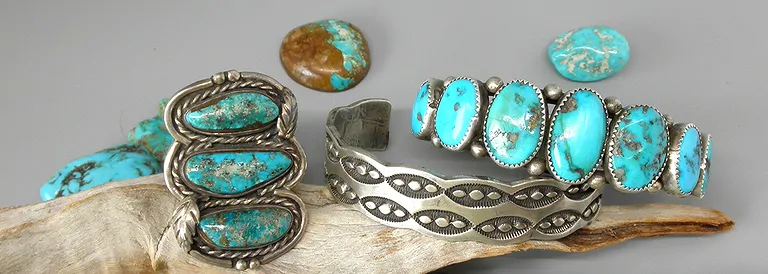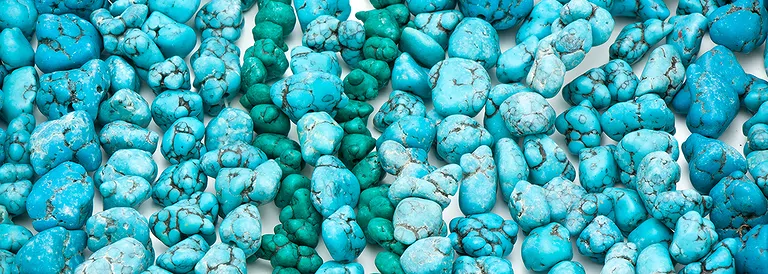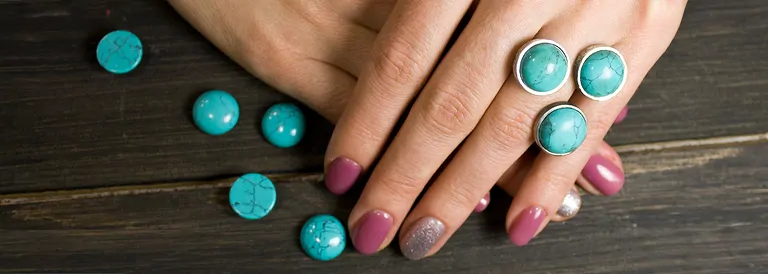
Turquoise - meaning, effect and application
Turquoise is one of the oldest known gemstones and has been popular for thousands of years. In gemstone healing, turquoise is regarded as the stone of travelers, which helps to distance oneself from external influences and to take necessary breaks. According to tradition, turquoise is said to change color when danger threatens and thus warn its owner. Turquoise was and is therefore often worn as an amulet or jewelry.
Origin of the name and synonyms
The name turquoise is derived from the French term "pierre turqouise" (Turkish stone). Turquoise first arrived in Europe during the Crusades when crusaders and Turkish tribes met and were used to make jewelry.
A now rare synonym for turquoise is kallaite; this name is derived from the Greek word "kallainos" (iridescent green and blue). Other synonyms are agaphite, arizonite, callaina, chalchuit, henwoodite, johnite and sinai stone. Cretaceous turquoise (see below) is also called plattnerite. The term Eilat stone is used to describe a naturally occurring mixture of chrycocoll, malachite and turquoise.
The term Californian turquoise or Utha turquoise refers to light green variscite.
Stringed beads, bracelets and more turqouise for jewery shops and DIY bead stringer

Historical aspects of the use of turquoise
Turquoise is one of the oldest gemstones and healing stones in human history - turquoise was mined in Egypt as early as 6000 BC. As the color of the gemstone is reminiscent of the sky and the sea, turquoise became a sacred stone for the Tibetans. Pliny the Elder (ca. 23 - 79 AD) wrote about turquoise that it was particularly popular as a gemstone in Carmania (southern Persia), where it was considered a lucky charm.
The Persian scholar Al Kazwini (ca. 1203 - 1283) wrote: “The hand that wears a turquoise and seals with it will never be poor”. Turquoise was considered an attribute of wealth. As it was believed that turquoise protected against unnatural death, it was worn by many Persian kings. By changing color, turquoise was said to warn of impending doom and the "evil eye" of disfavored people. Turquoise was therefore often used in turbans.
Turquoise has always been highly valued by the North American Indians; together with coral ans shells, it is still the most popular gemstone there today. The modern Mohave stone takes up the classic color palette of turquoise and red-orange.
Information on the Mohave stone
The color of turquoise
The color scale of turquoise ranges from green to sky blue to the typical “turquoise” blue-green. The stone is often interspersed with veins of brown limonite or black manganese oxide, or has inclusions of pyrite. Which type of turquoise is preferred as a gemstone depends not only on personal taste but also on the region. For example, most Italian jewelers and jewelry stores sell the homogeneous sky-blue Arizona turquoise without veins or inclusions.

Turquoise with matrix (bedrock)
In addition to the completely homogeneous turquoise such as that found in the Sleeping Beauty mine in the USA, turquoise is fascinating due to the contrast between the bright green-blue mineral and the gray, brown or black mother rock, the matrix. These usually run through the stone like veins. Whether the pure turquoise or the turquoise with matrix is considered the more beautiful and therefore more valuable depends on personal taste and regional differences.
A black matrix is caused by iron sulphide; this is the most common matrix color, yellow matrix is caused by rhyolite, brown matrix by one or more of a total of 16 different types of iron oxide.
For retailer: braceltes, pendants and more turqouise items
Mineralogical profile turquoise
Chemical formula, mineral class: CuAl6[(OH)2/PO4)]4 . 5H20,, phosphates
Formation: sedimentary, through weathering of rocks rich in aluminum phosphate
Color: sky blue to blue-green
Luster: waxy luster
Crystal system: triclinic
Mohs hardness: 5 to 6
Cleavage, fracture: no cleavage, uneven fracture
Occurrence, main supplier countries: USA (Arizona, New Mexico, here through Indian cultures since prehistoric times), Mexico, Afghanistan, China, Israel, Iran, northern Chile. However, many historically known copper mines in which turquoise was extracted have now closed. Commercial turquoise comes mainly from China, Mexico, the USA and Chile.
Appearance: as fissure filling, grape-like coating or as nodules, sometimes with pyrite inclusions and veining of limonite
Usage: Turquoise is a classic gemstone and in many cultures is also a component of cult objects. It is traditionally regarded as a protective stone. In gemstone healing, turquoise is used to balance mood swings and mobilize one's own energy reserves. In the Native American medicine wheel, turquoise is the totem of the puma moon (Pisces). Astrology uses it to help Pisces-born people to better protect themselves from external influences.
Availability: low

Treatments and enhancements of turquoise
As the supply of turquoise lags far behind the demand for beautiful stones, various processes for enhancing turquoise have become established on the market.
Stabilization with paraffin
The rough stone is placed in a bath of water with paraffin and soaked up like a sponge. The aim is to maintain stability and color permanently. This process is very common in the jewelry sector, especially with matrix turquoise. Only after stabilization is it possible to cut, drill and polish turquoise; without stabilization, the vast majority of rough stones would crumble.
Poliresin polish
After the last grinding step, the turquoise is polished with the synthetic resin polyresin. Polyresin penetrates the uppermost layers, giving the stone a particularly intense color, a beautiful shine and a very smooth surface.
Impregnation
A mostly colorless plastic binder is applied to the turquoise after grinding. The aim is to seal the surface and protect the turquoise from fading and drying out,
Zachery method
Treating turquoise with the zachery method is an alternative to stabilizing the stones. It can also be used to process porous stones that would normally break when cut. The zachery method is very time-consuming, as the turquoise is heated over a period of several weeks. As a result, the stones are easier to cut and grind and are also less sensitive to dirt, sweat and other impurities. The process was developed by engineer James Zachery, who came from a well-known US dynasty of turquoise traders. It can only be carried out with turquoise. The exact procedure of the Zachery method is still a well-kept secret several decades after its introduction. Proof is only possible at the molecular level.
At wholesale prices: earrings, necklaces and more turqouise articles
Special turquoises of natural and artificial origin
Turquoise is one of the most frequently forged gemstones. Blue-green colored magnesite is very common. These stones are often sold under the name turquenite or turkenite and must not be confused with genuine turquoise or traded as such. Over the decades, various processes have become established on the international gemstone market.
African turquoise
African turquoise is a trade name for various green-blue stones with a matrix, partly of natural and partly artificial origin. These include, for example, chrysocolla diorite and various greenish-black jaspers.
Mountain turquoise, mountain jade
This is not a turquoise, but a very uniform dolomite marble from Asia, which is very easy to dye. Depending on requirements and customer wishes, the light-colored rough stones can be dyed greenish, bluish or turquoise. Due to the uniformity of the material, mountain turquoise is often used as an inexpensive substitute for high-quality turquoise without inclusions.
Block turquoise, reconstructed turquoise
Block turquoise is made from remnants left over from cutting natural turquoise, resin and dyes. This is sold as a block about the size of a shoe box and then becomes cabochons. This process is often used for inexpensive jewelry with only small turquoises. In terms of color, block turquoise is often indistinguishable from very high-quality natural turquoise without inclusions (Sleeping Beauty and other mines). In some cases, no grinding residue is added, so that the material consists only of resin and dye.
Yellow turquoise
Yellow turquoise is a very attractive mixture of quartz and jasper, which usually comes from the same mines as natural turquoise. Predominant colors are yellow, gold, brown and green; usually a dark grey to black matrix is also present.
Imperial crown turquoise, imperial turquoise
This term is used to describe a very high-quality, sky-blue natural turquoise that can be cut into cabochons and other shapes without stabilization. As this turquoise is very expensive, only individual stones are usually sold rather than whole strands.
Chalk turquoise
Chalk turquoise is formed in deeper layers and has the same chemical composition as turquoise, but lacks the coloring copper. Chalk turquoise is therefore pale green, light blue, grayish or white.
The Mohs hardness is usually between 2 and 3 and the substance is more reminiscent of chalk than a gemstone. As chalk turquoise is very easy to dye and is visually very attractive due to the matrix that is usually present, it is often dyed and made into jewelry. The chalk turquoise must be stabilized before cutting.

Usage of turquoise in gemstone healing
Turquoise is a classic protective stone for gemstone healing, which is used especially when traveling. It helps to protect against external influences and protects against energetic attacks. It helps to balance out strong mood swings, cheers you up and can mobilize your own energy reserves. Turquoise promotes alertness, attentiveness and a zest for action, but at the same time supports inner peace and stability. It helps to recognize the causes of fate and promotes intuition
Turquoise should be worn with direct skin contact at the level of the solar plexus or in the neck area, but preferably not for too long. It is better to use the gemstone in specific situations in which it is needed. When turquoise is used as a chakra stone, it can be assigned to both the fourth, the heart chakra, and the fifth, the throat chakra. Astrologically, it is best suited to the signs Aquarius and Pisces.
Turqouise items (bracelets, stringed beads and much more) for retailer